Darksiders II Preview: The First Four Hours
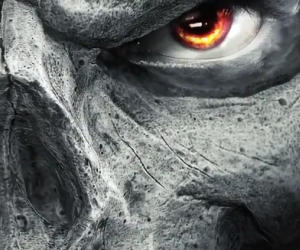 Death is coming…we take a look at one of our most eagerly awaited games of the year. Time to grab some loot and reap some souls.
Death is coming…we take a look at one of our most eagerly awaited games of the year. Time to grab some loot and reap some souls.
To say that a few GodisaGeek staffers are a little fond of Darksiders is quite the understatement. The 2010 release’s mix of action-adventuring and brutal combat made for one of this generation’s biggest surprises. What isn’t a surprise, is how much pressure there is for Vigil Games to create a sequel that matches the original in every way.
I have played the first 4-5 hours of Darksiders II, and my experience so far dictates that Vigil Games have somehow developed a sequel that feels like an entirely different game, even when the original game’s fundamentals have remained unchanged. This is all thanks to a magnificent array of refinements and all new additions.
The biggest of Darksiders II’s many new features are the all new RPG elements. The most important of these additions is the focus on equipment and its acquisition. Several categories of equipment can be obtained, from primary/secondary weapons to various different items of armour (all of which are colour-coded to indicate their rarity). Throughout Death’s adventure, these items are randomly obtained via opening chests and from destroying foes, with each individual item having its own unique statistics. You could, in theory, pick up several instances of the same weapon, each with different statistical strengths and weaknesses.
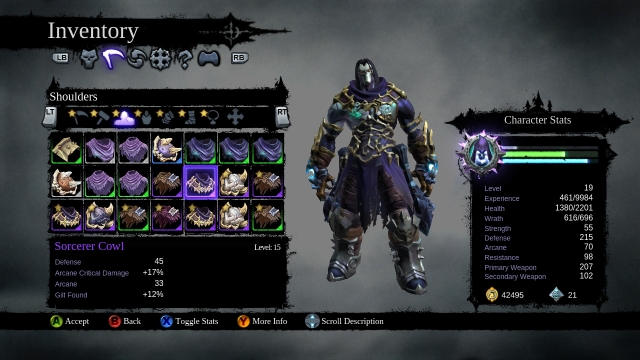
Of course, you only have a certain amount of space in your inventory in which to store your amassed loot but have no fear, there are multiple ways of clearing up space for that awesome scythe you are about to pick up. You could simply sell unused items to one of the many emporiums throughout the adventure. Thanks to the game’s new Tome messaging system, you could even send your unwanted item to friends (and also receive items from in-game NPC’s). Finally, you can “feed” your junk items to one of several “Possessed” weapons that can be obtained. You can upgrade these Possessed weapons at the cost of other items, each new level your Possessed weapon reaches increases its power and even allows you to choose what statistics are improved, from a list. If that wasn’t enough customisation for you, it is also possible to give your weapon its own name; personally, I found that “Arsekicker” was a suitable moniker for my powerful custom Scythe.
This time around, there are far more NPC’s to talk to and there are even simple dialogue options when engaging in conversation. From what I gather, these dialogue choices don’t seem to have much impact on the gameplay, but it’s these conversations that do end up giving you Secondary Missions to complete, as well as adding a little colour to the narrative. From these conversations it is also clear that Death is a completely different character to War. While the protagonist from the original game was a noble and honourable soul, his brother Death is threatening, cunning and not afraid to ruffle a few feathers in order to achieve his goals.
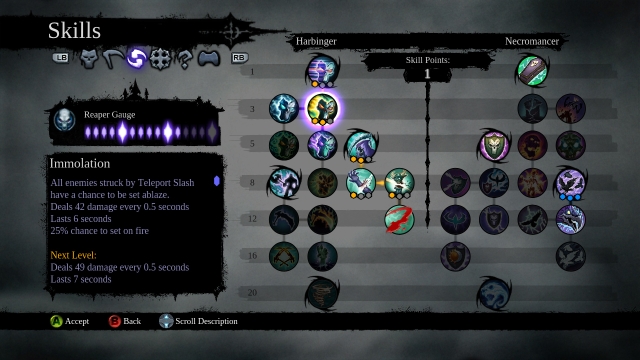
Earning enough XP to level up will reward you with a skill point that can used to purchase special skills (in either the melee-focused Harbinger or magic-focused Necromancer classes (or even both, if desired); as per the original game, these abilities deplete Wrath when used. Your first playthrough of the game will give you a level cap of 20, although the New Game+ feature will allow you to play the game a second (or more) time with a level cap of 30 (while retaining your equipment and skills from your previous playthrough). Extra skill points can also be earned via completing the new Secondary Missions. Some of the early skills in the game include the Harbinger classes Teleport Slash in which Death teleports towards opponents, delivering a deadly scythe strike that leeches health; meanwhile the Necromancy skill tree begins with Exhume, the ability to summon ghoulish minions that attack foes, while acting as a good distraction when dealing with mobs of enemies.
The amount of player-customisable skills and equipment (which actually changes the appearance of your character) really allows players to mould their character around their playstyle. You want to play a character that uses health-leeching special attacks, with fast-hitting secondary attacks while looking like a total badass? Vigil Games have you covered. Of course, should you change your mind, you can purchase a Respec from returning merchant Vulgrim, which allows you to wipe your chosen skills clean and put your hard-earned points into different abilities; he also sells boxes which contain random pieces of equipment (the more expensive the box, the better the item).
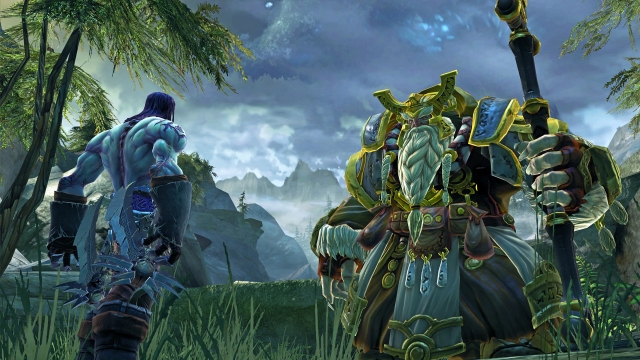
Another new feature that drives the RPG influences home, is the fact that whenever you deal or receive damage, floating numbers appear to advise you of it’s extent. This feature can easily be switched off in the options screen if it’s not to your taste. While these new features are heavily featured throughout the game, it is entirely feasible to not pay any attention to them and still enjoy the game. However, because these new features add so much depth and discovery to the whole game, why would you want to ignore them?
In terms of player control, Death is far more agile and deadlier than War ever was. He is quicker on his feet, and can even chain wall runs to traverse the trickiest of rooms, not to mention he’s more than capable of some wall jumping that would impress Metroid’s Samus Aran. Combat-wise, Death is an incredibly versatile fighter and, with the right choice in equipment, can easily be adapted to suit anyone’s playstyle. There is more of a focus on combining your attacks for effectiveness, including switching between Primary and Secondary weapons to create some absolutely deadly combos. Secondary Weapons are split into Light and Heavy types, and each weapon has its own charge moves, activated by holding the Y button (on Xbox 360). Leave your button-mashing at the door, as it’s skills that will get you those kills. It isn’t all about close-range brutality though, as relatively early on in the game you obtain a pistol created by Strife, Death’s brother (War wielded another of Strife’s guns in the original game). It may lack the bite of melee-weaponry, but it’s handy for dispatching smaller, airborne foes.
I played the game on Apocalyptic difficulty, which was the hardest setting in the original game; not in this sequel though. You see, Vigil Games have added something called Nightmare Mode. Unlocked by completing the game once, Nightmare Mode is as difficult as Apocalyptic, but with one small caveat, if you die in combat (i.e. Not an environmental death) you must begin the game from the start. You heard me correctly, all progress will be lost. There are no Achievements or Trophies linked to this mode, it is merely a challenge for the hardcore players out there. Now I see myself as a Darksiders veteran, and while I had no problems early on in the game, as the number of foes began to increase, and I started to take on the bosses of each dungeon, I died a fair few times, partly due to overconfidence on my part in terms of not stocking up on health potions (found in chests or purchased). Even I’m not intending to tackle Nightmare Mode.
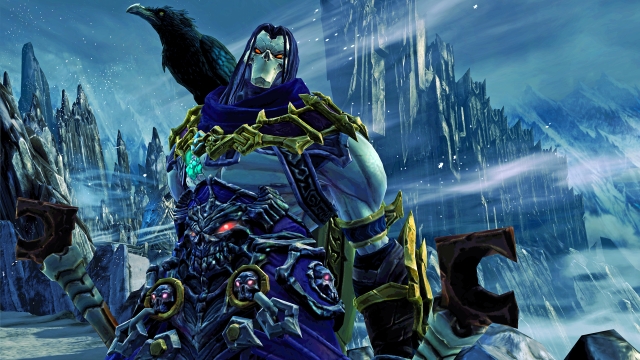
I simply cannot gush about this game enough. I haven’t even written about the gorgeous visuals and beautifully designed environments. As mentioned earlier this game is far more fantasy-focused than the original and the breathtaking fields, atmospheric dungeons and perilous mountains of Darksiders II are a far cry from the dull, grey and brown settings of other dark and violent games on the market today. The game’s framerate has been increased over the original game, making Death feel even more agile. Then there is the audio, consisting of brilliant voice acting and another amazing Jesper Kyd soundtrack. With the new loot and RPG features there is a ton of gameplay to be experienced, and a whole heap of replay value in terms of New Game+.
Put simply, in seven years and two games, Vigil Games have demonstrated absolute mastery of the action-adventure genre. While you’ll have to wait until the game’s released for a review, I can’t see any reason why this game will not be a Game of the Year contender. This is a glittering example of how you do a sequel.
Keep your iTunes/Stitcher/Feedburner podcast feeds primed for a very special Godcast Extra in the next couple of weeks, in which I chat to Lead Designer Haydn Dalton and Art Director Han Randhawa about Darksiders II, the modern games industry, and The Most Important Question Ever Asked. Until then, check out some new screenshots below!
[nggallery id=981]




